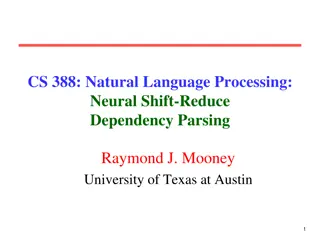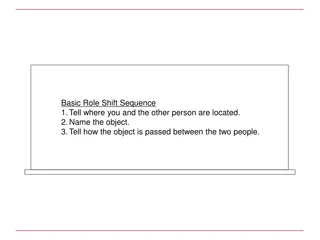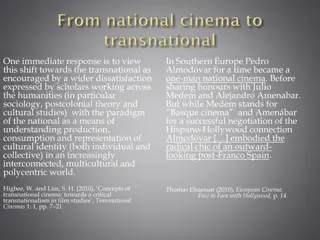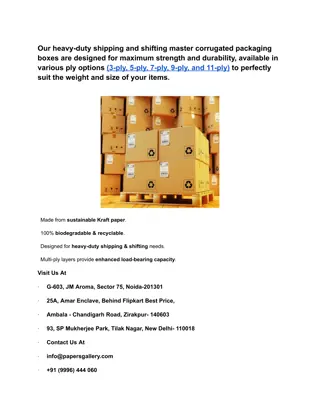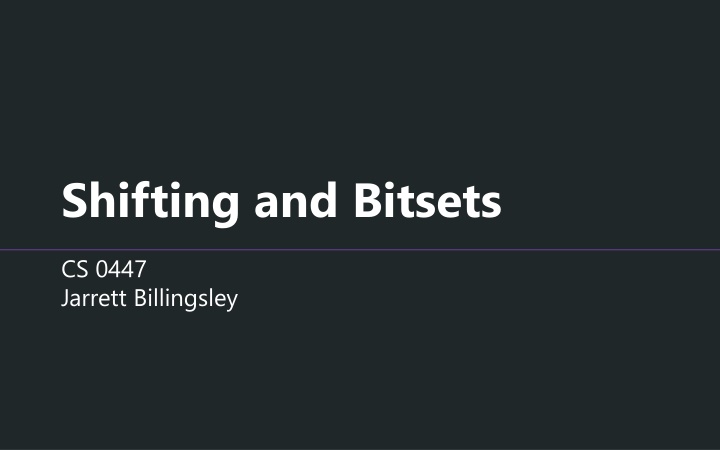
Practical Applications of Bit Shifting and Bitsets in Java
Explore the practical applications of bitwise operations such as left-shifting and right-shifting in Java, with examples and explanations. Understand how bit shifting can be used for fast calculations and optimization in programming.
Download Presentation

Please find below an Image/Link to download the presentation.
The content on the website is provided AS IS for your information and personal use only. It may not be sold, licensed, or shared on other websites without obtaining consent from the author. If you encounter any issues during the download, it is possible that the publisher has removed the file from their server.
You are allowed to download the files provided on this website for personal or commercial use, subject to the condition that they are used lawfully. All files are the property of their respective owners.
The content on the website is provided AS IS for your information and personal use only. It may not be sold, licensed, or shared on other websites without obtaining consent from the author.
E N D
Presentation Transcript
Shifting and Bitsets CS 0447 Jarrett Billingsley
Class announcements there are a couple Java examples on the materials page! today we ll see more practical applications of the bitwise operations that we learned about last time o BUT FIRST... a few more operations CS447 2
Bit shifting CS447 3
Bit shifting besides AND, OR, and NOT, we can move bits around, too. if we shift these bits left by 1 we stick a 0 at the bottom. 1 1 0 0 1 1 1 1 1 1 0 0 1 1 1 1 0 again! 1 1 0 0 1 1 1 1 0 0 AGAIN! 1 1 0 0 1 1 1 1 0 0 0 AGAIN!!!! 1 1 0 0 1 1 1 1 0 0 0 0 CS447 4
Left-shifting in C/Java and MIPS (animated) C/Java/Python/etc. use the << operator for left shift: B = A << 4; // B = A shifted left 4 bits MIPS has the sll (Shift Left Logical) instruction: sll t2, t0, 4 # t2 = t0 << 4 but wait. if the bottom 4 bits of the result are now 0s o what happened to the top 4 bits? 0011 0000 0000 1111 1100 1101 1100 1111 the bit bucket is not a real place it's a programmer joke ok bits that get "shifted off" the top are discarded. this is really a kind of truncation, and may or may not lead to strange results! Bit Bucket CS447 5
So what does it DO? let's start with a value like 5 and shift left and see what happens. Binary Decimal 00000101 5 00001010 10 00010100 20 00101000 40 01010000 80 why is this happening well uh... what if I gave you 49018853 how do you multiply that by 10? by 100? by 100000? something very similar is happening here! CS447 6
a << n == a shifting left by n is the same as multiplying by 2n. o you probably learned this as "moving the decimal point " o and moving the decimal point right is like shifting the digits left. to quickly calculate powers of 2, shift 1 left by the desired exponent. o e.g. (1 << 5) == 1 25 ==25 with bit shifting, we're moving the binary point (yes, really) shifting is very fast on most CPUs! o way faster than multiplication in any case o HLL compilers will try really hard to replace "multiplication by a constant" with shifts and adds 2n CS447 7
<_< >_> we can shift right, too. 0 0 1 1 0 0 0 0 0 0 0 0 1 1 1 1 1 1 0 0 1 1 0 1 1 1 0 0 1 1 1 1 0 0 0 1 1 0 0 0 0 0 0 0 0 1 1 1 1 1 1 0 0 1 1 0 1 1 1 0 0 1 1 1 0 0 0 0 1 1 0 0 0 0 0 0 0 0 1 1 1 1 1 1 0 0 1 1 0 1 1 1 0 0 1 1 0 0 0 0 0 1 1 0 0 0 0 0 0 0 0 1 1 1 1 1 1 0 0 1 1 0 1 1 1 0 0 1 0 0 0 0 0 0 1 1 0 0 0 0 0 0 0 0 1 1 1 1 1 1 0 0 1 1 0 1 1 1 0 0 C uses >>, Java uses >>>, MIPS uses srl (Shift Right Logical). 32 bits on a slide is a bit much well if shifting left is like multiplying, then ? CS447 8
a >>> n == a shifting right by n is the same as dividing by 2n. Binary Decimal 01010000 80 2n that's what integer division gives us too, right? 40 00101000 5 / 2 == 2 20 00010100 10 5 2 00001010 00000101 00000010 but soon we'll see that right- shifting and division can sometimes disagree. CS447 9
Signed numbers messing things up again since they use the MSB as the sign bit, we have a problem. if we shift this right Unsigned Signed = 172 = 86 = 43 = -84 = 86 = 43 1 0 1 0 1 1 0 0 0 1 0 1 0 1 1 0 0 0 1 0 1 0 1 1 well that's a little unfortunate. Arithmetic Right Shift is used for signed numbers: it "smears" the sign bit into the top bits. = -84 = -42 = -21 1 0 1 0 1 1 0 0 1 1 0 1 0 1 1 0 1 1 1 0 1 0 1 1 Java uses >>, MIPS uses sra (Shift Right Arithmetic) CS447 10
Uh oh, they're fighting let's look at the values we get as we divide and shift. n a / 2n a a >> n -8010 -4010 -2010 -1010 -510 -310 -210 -110 0 101100002 110110002 111011002 111101102 111110112 111111012 111111102 111111112 -8010 -4010 -2010 -1010 -510 -210 -110 010 well that's a little weird. 1 actually, this is correct. but so is the way that integer division works. they're both right. 2 3 4 5 (we'll come back to this.) 6 7 CS447 11
Bit sets CS447 12
Booleans are wasteful! there are a lot of problems out there that involve storing large numbers of boolean (true/false) values. a boolean variable in Java (or bool in C/C++/Rust/many others) usually takes up an entire 8-bit byte to store 1 bit of information. a much more efficient way to store large numbers of booleans is by treating the bits of integers as arrays of booleans. this technique goes by a few names bit flags, bit arrays, bit vectors, bit maps, or bit sets, which is the term we ll be using. o the Bitset.javaexample shows why we call them bit sets because 1 means in the set and 0 means not in the set ! there s no syntax for accessing bits this way, but you can imagine we need to be able to do three things: bits[n] = 1, bits[n] = 0, and if(bits[n] != 0). CS447 13
Turning bits on (bits[n] = 1) let s say I have a pattern of 4 bits which control some LEDs. what if I want to turn on just bit 1? but importantly, we want to do it without changing any of the others. 1 3 0 2 0 1 0 0 Bit # which bitwise operation takes two values and can output a 1 when one of its inputs is 0? 1 0 0 0 1 0 0 | 0 if I just want to turn on bit 1, what pattern of bits will I use? 1 0 1 0 is there a way to generalize this pattern based on the bit s number? CS447 14
The pattern for bit n is (bits[n] = 1) let s see. To turn on bit #... OR with 0 00012 1 00102 2 01002 3 10002 bitwise 0 3 0 2 0 1 0 0 Bit # wait a second. these look like shifted versions of each other! you start with 1 and shift it left by the number of the bit you want to turn on. so: to turn on bit n, you do: bits = bits | (1 << n); or more tersely, bits |= (1 << n); CS447 15
Turning bits off (bits[n] = 0) now I want to do the opposite. I want to turn offjust bit 2. which bitwise operation takes two values and can output a 0 when one of its inputs is 0? 1 3 1 2 1 1 0 0 the pattern of bits needed looks odd.... 1 1 0 1 1 0 1 but this pattern of bits is not arbitrary. remember that (1 << 2) = 01002 & 1 1 0 1 0 this is the complementof(1 << 2)! to turn off bit n, you do: bits = bits & ~(1 << n); or more tersely, bits &= ~(1 << n); CS447 16
Testing if bits are 1 or 0 (if(bits[n] != 0)) now we have a pattern of bits that represents buttons being pressed. I want to see if button 1 is pressed and do something based on that. I want to sort of filter out or ignore the bits other than bit 1. all I care about is seeing if bit 1 is 0 or not-0. I can filter out bits by turning them off. which operation turns off bits? 1 3 0 2 1 1 0 0 1 0 0 1 1 0 0 once again, (1 << n)is the bit pattern, but this time we don t bitwise NOT it. & 0 so: to test bit n, you do: if((bits & (1 << n)) != 0) 0 0 1 0 CS447 17
These are set operations these aren t just arrays of bits. they represent sets. so... 0 1 1 0 & 1 0 1 0 AND gives the intersection, the set of things that are in both sets. 0 0 1 0 0 1 1 0 1 0 1 0 OR gives the union, the set of things that are in either set. | 1 1 1 0 0 1 1 0 ^ 1 0 1 0 the symmetric set difference is the set of items in one set but not both... what boolean operation is this? 1 1 0 0 XOR! CS447 18
Masking CS447 19
Masquerade we just saw that bitwise AND can turn off bits while leaving others untouched, which let us filter out unwanted bits. a mask is a specially-constructed value that has: o 1s in the bits that we want to keep o 0s in the bits that we want to discard what if I want to isolate the lowest 5 bits of a number? 00000000000011111100100001001011 00000000000000000000000000011111 & 00000000000000000000000000001011 this is masking: ANDing a value with a mask to isolate some bits by turning off the others. to isolate the lowest n bits, AND with 2n-1. or, bits & ((1 << n) 1) CS447 20
Another way to make masks what if you don't waaaaaanna calculate 2n-1? think of it this way: to extract n bits, you need n 1s (in binary). o so write that many 1s, then convert to hex, which is easy. n Binary Mask 1 2 3 4 5 6 11 1111 7 111 1111 Hex Mask notice the pattern in the hex versions. 1, 3, 7, F and then it repeats. 1 0x1 11 0x3 111 1111 0x7 0xF I don't even think of the binary anymore. I just go: "13 bits? 0xFFF gives me 12, then put 1 in front of that 0x1FFF." 1 1111 0x1F 0x3F 0x7F CS447 21
Masking can also do modulo! something arithmetically useful that masking can do: we re kind of truncating this value to 3 bits, right? and truncation performs modular arithmetic so this does 53 % 8. 00110101 = 53 = 8 - 1 & 00000111 00000101 = 5 so, if you want to modulo by 2n, AND with 2n-1. or, a % 2n == a& ((1 << n) - 1) note that this only works for powers of 2! you cannot do x & 49to do x % 50 because 50 is not a power of 2. CS447 22










